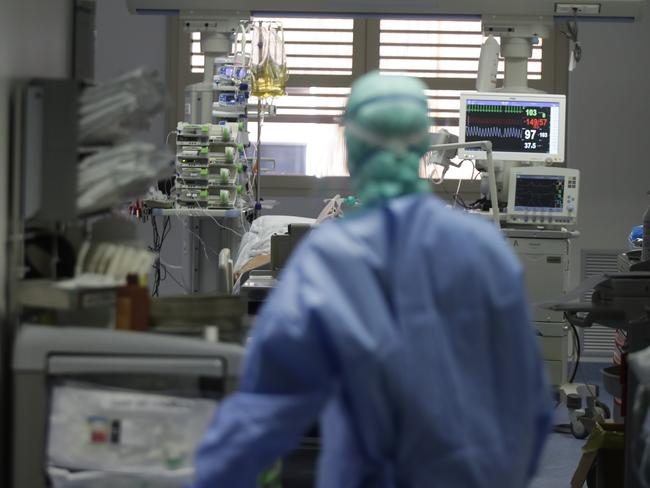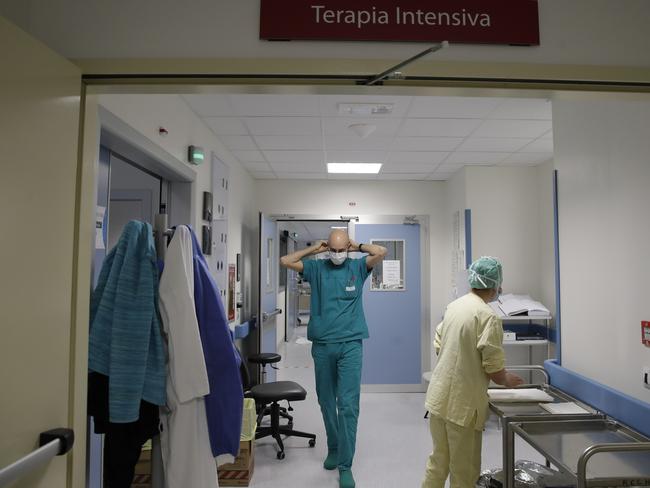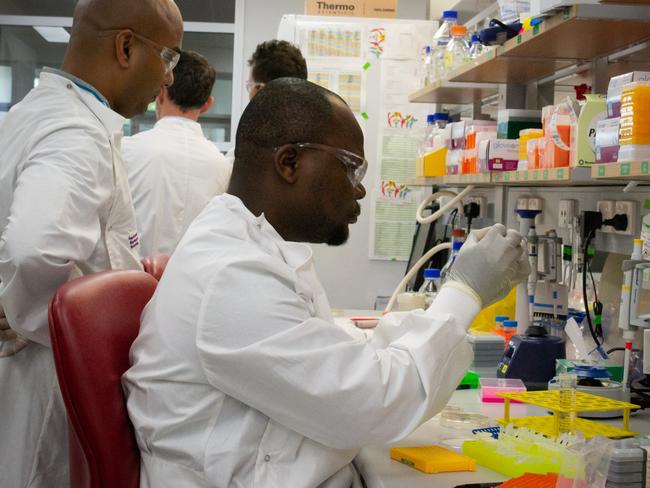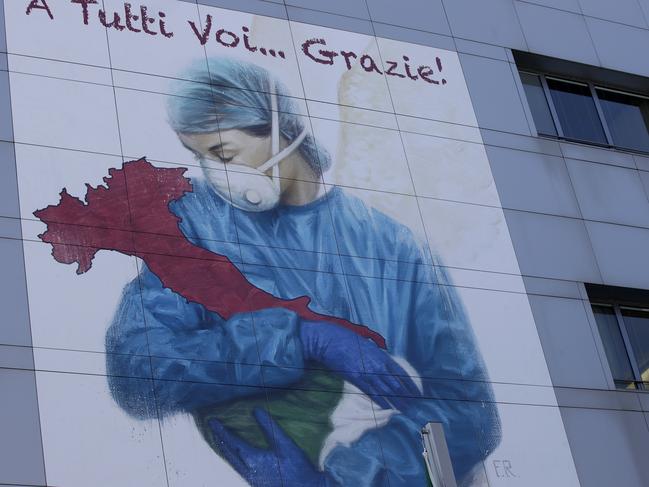How close is a coronavirus vaccine to becoming a reality? This is what you need to know about a COVID-19 cure
As nations close their borders to overseas visitors in a bid to stop the deadly spread of coronavirus, Australian scientists are at the forefront of a global push to develop a vaccine.
National
Don't miss out on the headlines from National. Followed categories will be added to My News.
As countries shut their doors to overseas visitors in a bid to stop the spread of coronavirus, Australian scientists are at the forefront of a global push to find a vaccine without borders.
Teams of scientists across the world are working around the clock to either develop a new drug or repurpose an existing medication to halt the spread of the virus.
This quest for a vaccine for COVID-19 is proceeding at a spectacular pace with some scientists skipping animal trials as they race to find a way of halting the terrifying death toll.
Scientists, academics and medical journals are freely sharing early results of clinical trials before they are peer reviewed to progress research as quickly as possible.
But how close are we to a vaccine?

MORE NEWS
Myer, David Jones plea to boost retail
Shoppers warned of online delivery delays
Lewis Hamilton reveals Aussie heartbreak
Even with sidestepping normal procedures such as initially testing on animals – it is expected it will take 12-18 months to find a vaccine.
Large scale human trials are needed before everyone can be inoculated and there are major risks.
We don’t yet know whether these vaccines will provide immunity to COVID-19, or whether immunity will be short lived.
People infected by other coronaviruses that cause common colds can still become infected even though they have antibodies to the virus.

MOUSE TRAP
There is a desperate race within the race to produce new supplies of a transgenic mouse that can help researchers understand the virus.
In the US, the Jackson Laboratory has been overwhelmed by requests to supply a mouse it bred for the 2003 SARS outbreak that produces a human version of the protein ACE2 which the coronavirus uses to enter human cells.
Normal mice are resistant to the new coronavirus.
CHINA
The first country to experience the virus and also the first to start searching for vaccines and cures, China is understandably leading the field in the hunt for a vaccine.
To create an original vaccine, the Chinese company Beijing Advaccine Biotechnology is working with a US biotech company called Inovio Pharmaceuticals. They are in the process of developing a “DNA vaccine” called INO-4800.
This vaccine is already in preclinical trial. It involves directly injecting genetic material into a person to trigger a stronger immune response, so they are better equipped to stop an infection.
US
The first human trial of a COVID-19 vaccine began in the US this week with four people injected with a low dose of a vaccine developed by US company Moderna even before animal trials had started.
The initial trial is expected to involve 45 healthy adult volunteers between the ages of 18 and 55 years over approximately six weeks. It could take 12 months before any concrete results are produced.

AUSTRALIA
Researchers at Queensland University are hoping to begin animal trials of its COVID-19 vaccine next month.
The trials will take place at CSIRO’S Geelong laboratory.
Griffith University announced on Thursday it has signed a memorandum of understanding with Queensland-based Luina Bio to work on a vaccine against the virus.
Also,
Australian scientists from University of Queensland began a clinical trial of a treatment they claim could “cure” COVID-19.
The first human clinical trial began for a vaccine and several new blood tests for the virus that take just 10 minutes to produce a result were launched this week.

THE DANGERS
There are vital safety concerns about a COVID-19 vaccine and scientists want to avoid a phenomenon where people vaccinated against the disease but who get infected develop a more severe case.
Ferrets given an experimental vaccine against another coronavirus SARS in 2004 developed damaging inflammation in their livers after being infected with the virus even though they’d been vaccinated.
The vaccine project was helped this week when The Doherty Institute in Melbourne reported it had mapped how the body’s immune system fights the virus after studying a 47-year-old woman who had the virus in Australia.
TREATMENT
Australia:
Later this month, coronavirus patients in 50 Australian hospitals will be given two drugs used to treat malaria and HIV AIDS in a clinical trial that promises to “cure” the virus.
University of Queensland Centre for Clinical Research Director Professor David Paterson, who is running the trial, said the drugs were shown to be effective against the virus in test tubes and Australian patients given the medications completely cleared the virus.
“These medications have the potential to be a real cure for all, unlike the random anecdotal experiences of some people,” he said.
The medication being used in the trial are HIV treatment Kaletra and malaria treatment Hydroxychloroquine.
A Chinese study involving 200 people reported this week that Kaletra did not work.
Patients given Kaletra had no better outcomes and similar death rates to people who were not given the drug.

France:
Meanwhile a French study in 24 patients has found a cheap treatment for malaria hydroxychloroquine appears to works against COVID-19 especially when combined with an antibiotic azithromycin used to treat bacterial lung disease.
Twenty five per cent of patients who received the drugs tested positive for the virus after six days, compared with 90 per cent of those who did not receive it.
The World:
Japan’s Fujifilm – yes the photographic company – also makes a drug called Favipiravir. This was initially intended to treat new strains of the flu. However, it appears to be proving effective in treating coronavirus patients, particularly those with lighter symptoms.
In a Chinese trial involving 340 people, the virus cleared up in just four days in those who received the drug, versus 11 days in those who did not receive it.
Multiple trials are under way using the experimental broad spectrum antiviral drug HIV medication Remedsivir which works by stopping the virus’s ability to replicate itself.
First results due are due next month but it may need to be administered early to work.
UK company Synairgen is trialling interferon beta, an immune system molecule that is part of the lung’s natural defence system against viruses to combat COVID-19.
Other clinical trials are using blood plasma from patients who have recovered from the virus which is then injected into sick patients to jump start their own immune response.
US company Regeneron is working on isolating the active parts of the plasma to turn it into a drug.
TESTING
In Australia, testing for COVID-19 was this week rationed to only those who had been overseas, in contact with an infected person or with unexplained pneumonia as queues formed at public hospitals and test kits ran low.
Diagnostic company Roche moved to bring another 97,000 test kits to Australia but then a shortage in the swab kits needed to take the mucus samples for analysis emerged.
The Doherty Institute in Melbourne which was the first lab to grow the COVID-19 virus outside China has devised its own homegrown test said it had completed over 20,000 tests.
UK company SureScreen diagnostics said it had developed a 10-minute blood test that could tell if a person had COVID-19 but only if they were 3-7 days into the infection.
Australian rapid blood test company Atomo Diagnostics Limited and UK’s Mologic announced they were developing a rapid self-tests for COVID-19 that could deliver results in as little as 10-15 minutes.
These blood tests detect the presence of antibodies generated in the body in response to the virus.
Since the outbreak began in Australia around 100,000 Australians have been tested and only a tiny percentage have been found to have the virus.
Australian Medical Association South Australian president Chris Moy said once the virus became more widespread people were unlikely to be tested at all and doctors instead would focus on ordering X-rays of the lungs of those with the most severe forms of the virus.
LOGISTICS
Twenty per cent of people infected with COVID-19 will become seriously ill and five per cent will require an ICU bed equipped with a ventilator and Australia may not have enough in a serious outbreak.
Currently Australia has around 2,200 ICU beds and plans are afoot to almost double that number by repurposing beds in operating theatres and taking ventilators from other areas of the health system.
NSW Health has estimated a surge in the virus could see demand for ICU beds soar to 330 per cent of capacity in the next six months.
State governments have put in orders for hundreds of extra ventilators but as the virus spreads around the world we are competing with other countries for limited supplies and the machines are made overseas.
The Queensland health department has acquired an additional 110 ventilators and said its hospitals are prepared to triple emergency department capacity and double intensive care unit capacity.
Victoria has order an extra 150 ventilators.
To clear more room in public hospitals for an expected flood of COVID-19 patients, state governments are bringing forward urgent elective surgery, transferring other elective surgery to private hospitals and are trying to recruit retired doctors and nurses to bolster the medical workforce.
Australia had a stockpile of over 19 million face masks needed to protect doctors from the virus when the outbreak began but these need to be changed regularly throughout the day and in a large scale outbreak this will not be enough.
The government has order another 54 million masks and local manufacture of masks has been stepped up.
Australian Defence Force personnel have been called out under the Defence Assistance to the Civil Community (DACC) rules to help Shepparton company Med-Con produce supplies of personal protective equipment.
